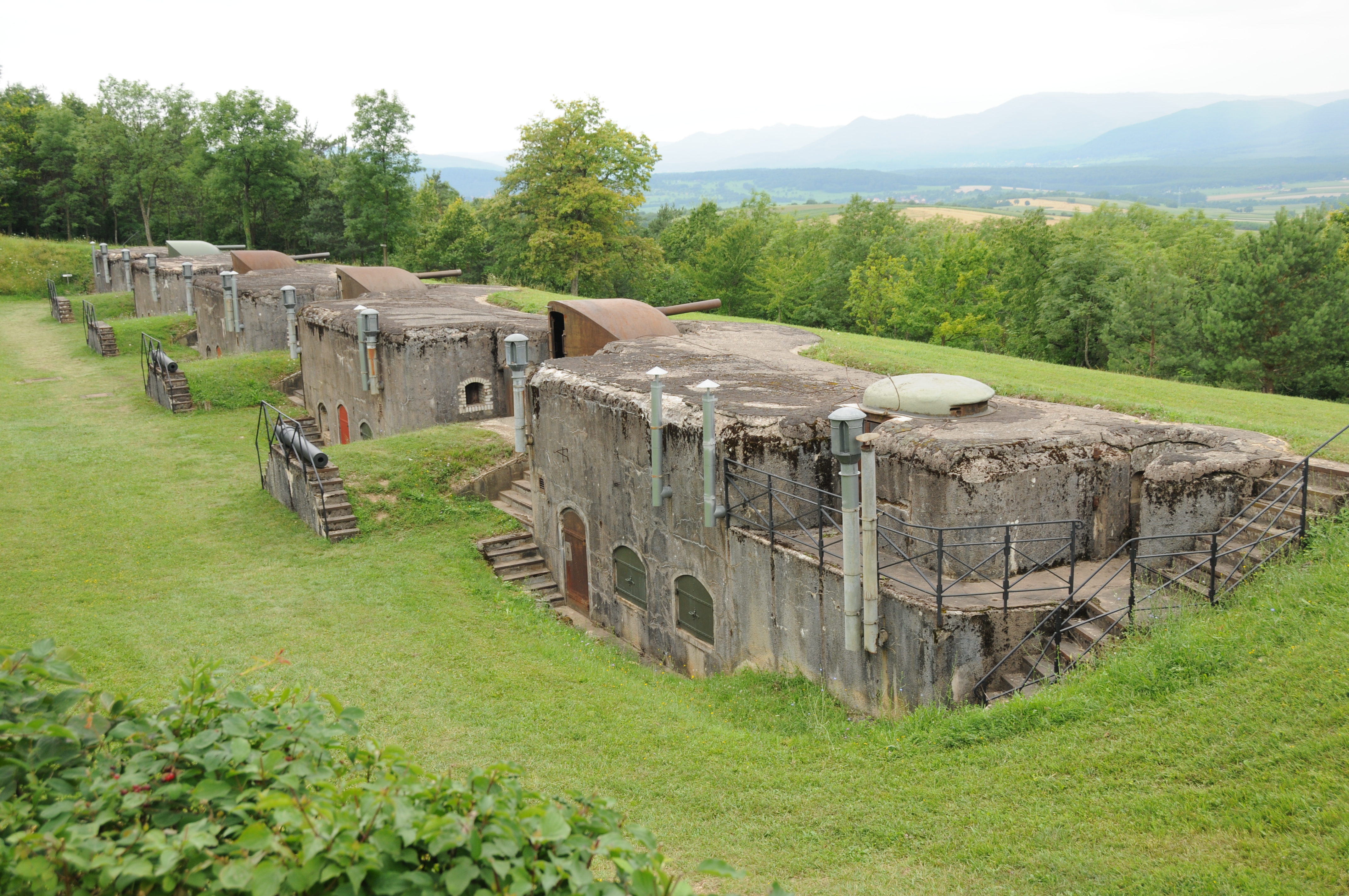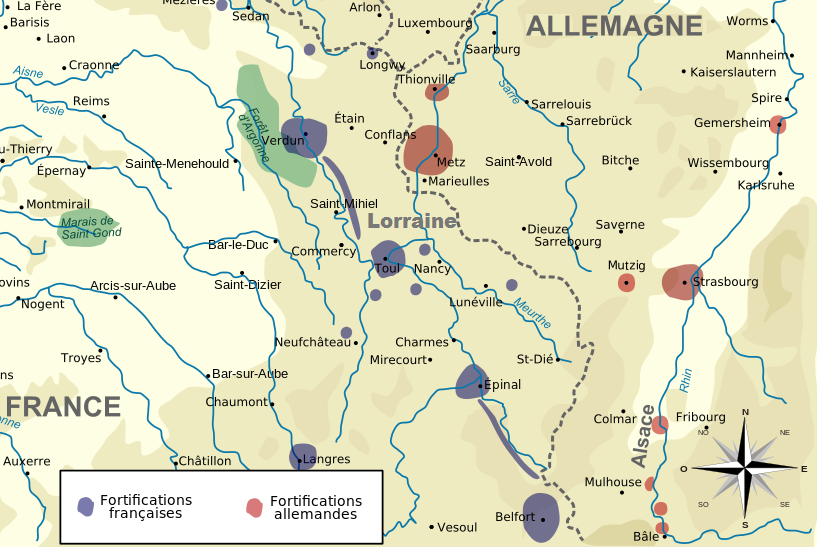Fort de Mutzig on:
[Wikipedia]
[Google]
[Amazon]
The Fort de Mutzig, also known as Feste Kaiser Wilhelm II, is located near the town of


 The fortifications comprise three main portions. The newest section, and the place used for tours, is located in the northwestern fort. The 1895 west fort is located somewhat to the south, and the eastern fort about one kilometer to the east of the western fort. Together they comprise a ''Feste'', or fortification, a concept which was later developed in the construction of the French
The fortifications comprise three main portions. The newest section, and the place used for tours, is located in the northwestern fort. The 1895 west fort is located somewhat to the south, and the eastern fort about one kilometer to the east of the western fort. Together they comprise a ''Feste'', or fortification, a concept which was later developed in the construction of the French
Fort de Mutzig
site
Fort de Mutzig
at Chemins de mémoire
at Traces of War {{Authority control
Mutzig
Mutzig ( or ; german: Mützig) is a commune in the Bas-Rhin department in Grand Est, in north-eastern France. The commune of Mutzig is located at the entrance of the Bruche river valley, on the Route des Vins d'Alsace.
History
Evidences of ...
, in the Bas-Rhin
Bas-Rhin (; Alsatian: ''Unterelsàss'', ' or '; traditional german: links=no, Niederrhein; en, Lower Rhine) is a department in Alsace which is a part of the Grand Est super-region of France. The name means 'Lower Rhine', referring to its lo ...
department of France
France (), officially the French Republic ( ), is a country primarily located in Western Europe. It also comprises of Overseas France, overseas regions and territories in the Americas and the Atlantic Ocean, Atlantic, Pacific Ocean, Pac ...
. It is one of the fortification
A fortification is a military construction or building designed for the defense of territories in warfare, and is also used to establish rule in a region during peacetime. The term is derived from Latin ''fortis'' ("strong") and ''facere ...
s built by Germany
Germany,, officially the Federal Republic of Germany, is a country in Central Europe. It is the second most populous country in Europe after Russia, and the most populous member state of the European Union. Germany is situated betwee ...
at the end of the 19th century to defend Strasbourg
Strasbourg (, , ; german: Straßburg ; gsw, label= Bas Rhin Alsatian, Strossburi , gsw, label= Haut Rhin Alsatian, Strossburig ) is the prefecture and largest city of the Grand Est region of eastern France and the official seat of the ...
.
It was the first new fortification built in what was then German territory after the invention of high explosives, which rendered earlier masonry fortifications obsolete.
Concept
Fort de Mutzig was part of a network of forts surrounding Strasbourg andMetz
Metz ( , , lat, Divodurum Mediomatricorum, then ) is a city in northeast France located at the confluence of the Moselle and the Seille rivers. Metz is the prefecture of the Moselle department and the seat of the parliament of the Grand ...
that had been built by the Germans after the end of the Franco-Prussian War. Earlier forts built from 1872 to 1880 used masonry, which did not resist high explosives, or concrete. The Mutzig works were planned as a demonstration of new technology.
The western fort, built in 1895, was built of concrete from the beginning, while the 1893 eastern fort, which had been built in masonry, was reinforced and covered in concrete. Armored observation points and 150mm howitzer
A howitzer () is a long- ranged weapon, falling between a cannon (also known as an artillery gun in the United States), which fires shells at flat trajectories, and a mortar, which fires at high angles of ascent and descent. Howitzers, like ot ...
turrets
Turret may refer to:
* Turret (architecture), a small tower that projects above the wall of a building
* Gun turret, a mechanism of a projectile-firing weapon
* Objective turret, an indexable holder of multiple lenses in an optical microscope
* M ...
were installed, while Mutzig was the first German fort with its own electricity generating plant. It also was equipped with a radio link to Strasbourg, infantry shelters and underground living quarters. Costs were estimated at 15 million marks.
Description


Maginot Line
The Maginot Line (french: Ligne Maginot, ), named after the Minister of the Armed Forces (France), French Minister of War André Maginot, is a line of concrete fortifications, obstacles and weapon installations built by French Third Republic, F ...
fortifications.
In 1914, the fort comprised 50 buildings, with an underground space of approximately 40,000 square meters (400,000 square feet). With 22 turrets equipped with 10 cm and 15 cm howitzers at a maximum rate of fire of 6.5 tons of shells per minute, Mutzig was one of the strongest forts in Europe. 8,000 troops of the German army manned the defenses of Strasbourg at the time. Forces were disposed in the ring of forts around Strasbourg, as well as the Vosges mountains
The Vosges ( , ; german: Vogesen ; Franconian and gsw, Vogese) are a range of low mountains in Eastern France, near its border with Germany. Together with the Palatine Forest to the north on the German side of the border, they form a singl ...
for defense against French forces around Belfort
Belfort (; archaic german: Beffert/Beffort) is a city in the Bourgogne-Franche-Comté region in Northeastern France, situated between Lyon and Strasbourg, approximately from the France–Switzerland border. It is the prefecture of the Terri ...
.
The fort's armament included:
* 8 x 150 mm howitzers in turrets with a range of
* 14 x 105 mm guns in turrets, of two models, with a range of up to
* 8 x 57 mm guns in mobile turrets
* 12 x 53 mm guns in embrasures
* 12 armored observation points, two with periscopes, and 7 infantry observation positions
Three concrete barracks for the garrison and 18 concrete shelters for infantry were provided, along with four wells, bakeries and other support facilities distributed around the fortification.
History
The province ofLorraine
Lorraine , also , , ; Lorrain: ''Louréne''; Lorraine Franconian: ''Lottringe''; german: Lothringen ; lb, Loutrengen; nl, Lotharingen is a cultural and historical region in Northeastern France, now located in the administrative region of Gra ...
had been captured during the Franco-Prussian War, prompting an arms race in the form of fixed fortifications on the parts of France and Germany. The fortress saw no significant fighting during the First World War
World War I (28 July 1914 11 November 1918), often abbreviated as WWI, was List of wars and anthropogenic disasters by death toll, one of the deadliest global conflicts in history. Belligerents included much of Europe, the Russian Empire, ...
, and was handed over intact to the French Army after the Armistice
An armistice is a formal agreement of warring parties to stop fighting. It is not necessarily the end of a war, as it may constitute only a cessation of hostilities while an attempt is made to negotiate a lasting peace. It is derived from the ...
of 1918, with the exception of about half of its 105 mm guns, salvaged in 1917 by the Germans. The French Army designated Mutzig a rear defense of the Rhine
), Surselva, Graubünden, Switzerland
, source1_coordinates=
, source1_elevation =
, source2 = Rein Posteriur/Hinterrhein
, source2_location = Paradies Glacier, Graubünden, Switzerland
, source2_coordinates=
, source ...
frontier.
During the Second World War the fortress was occupied for a time by German artillery and infantry regiments but on June 13, 1940 forces were ordered to evacuate the area and all the guns were decommissioned. Despite this, it was later bombed by the German Luftwaffe
The ''Luftwaffe'' () was the aerial-warfare branch of the German '' Wehrmacht'' before and during World War II. Germany's military air arms during World War I, the '' Luftstreitkräfte'' of the Imperial Army and the '' Marine-Fliegerabt ...
when it was suspected that French troops had taken possession. However, part of the Wehrmacht's 215th Infantry Division was in fact in the fortress at the time and more than 70 German soldiers were killed in the Stuka attack.
In November 1944 the US Third Infantry Division took the fortress, which was then thinly occupied by German forces who were forced to surrender after a short time for want of ordnance and reinforcements.
The Fortress today
After the Second World War the fortress was used by the French Army for exercises up until the 1960s when it was abandoned but remained in the possession of the military. As the fortress never saw substantial military action, it remains one of the best preserved pre-World War I
World War I (28 July 1914 11 November 1918), often abbreviated as WWI, was List of wars and anthropogenic disasters by death toll, one of the deadliest global conflicts in history. Belligerents included much of Europe, the Russian Empire, ...
sites in existence. This enormous site, which retains almost all its original equipment, has been under a process of restoration by a joint German–French group since 1984 and in 1995 a Museum was opened to the public together with some restored areas of the site. Local historical reenactment
Historical reenactment (or re-enactment) is an educational or entertainment activity in which mainly amateur hobbyists and history enthusiasts dress in historic uniforms or costumes and follow a plan to recreate aspects of a historical event or ...
groups also make use of the fortress. Since 2014 the fortress has been known by its original name, the Kaiser Wilhelm II fortress.
References
External links
Fort de Mutzig
site
Fort de Mutzig
at Chemins de mémoire
at Traces of War {{Authority control
Mutzig
Mutzig ( or ; german: Mützig) is a commune in the Bas-Rhin department in Grand Est, in north-eastern France. The commune of Mutzig is located at the entrance of the Bruche river valley, on the Route des Vins d'Alsace.
History
Evidences of ...
World War I museums in France
Buildings and structures in Bas-Rhin
Museums in Bas-Rhin